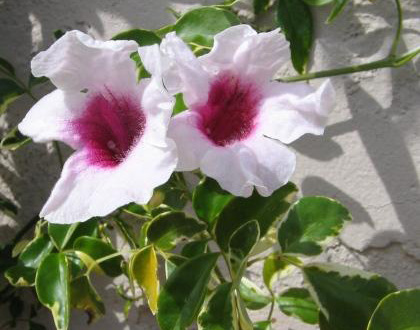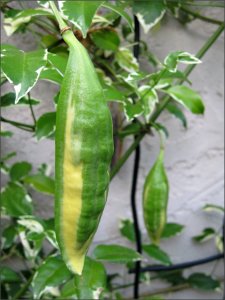Bower Vine, Jasmine, Pandorea jasminoides. Pink bower vine is a fast-growing vine that reaches heights of 20 to 30 feet at maturity. The vine adds color to the landscape all summer, displaying soft pink, bell-shaped blooms with dark pink throats. Thanks to the lush, evergreen foliage, the vine is attractive even when it isn’t blooming. Bower vine is suitable for planting in U.S. Department of Agriculture plant hardiness zones 9 to 11 (which is fine for Sunnyvale which is 9a).
Care of your bower vine
Extreme challenge: My bower vine is growing in a 3-inch wide trench.
The following info from http://homeguides.sfgate.com/maintain-pink-bower-vine-42750.html
Provide a supportive structure, such as a trellis or fence, for the vine to climb. Although bower vines climb with no assistance, you can train the vines if you want them to follow a specific growth habit. To train the vines, tie them to the support structure with soft garden twine.
Trim spindly, weak and dead stems and cut off faded blooms along with the stem, leaving only three buds on each stem. Do this every year after flowering. You can also thin the vine or maintain a desired size or shape. Bower vine tolerates hard pruning, but don’t cut the plant down to the ground. Replacing a badly neglected or unhealthy plant is a better alternative.
Water bower vine regularly during the first year. Water deeply to saturate the entire root zone. Avoid shallow irrigation, which creates shallow roots rather than deep, strong roots. Allow the top of the soil to dry between each watering. After the first year, normal rainfall is adequate.
Spread 2 to 3 inches of mulch around the plant to conserve moisture, enrich the soil and keep weeds in check. Use a mulch such as wood chips or dry leaves. Rake the mulch away from the stems, allowing a at least one to three inches between the stems and the mulch. Allowing the mulch to rest on the stems may lead to stem rot.
Feed pink bower vine in late spring and early fall for the first one to two years. Provide an additional feeding in midsummer if the growth appears weak. Use a regular garden fertilizer with a ratio such as 15-0-15, applied according to label specifications. Apply the fertilizer to damp soil, and then water deeply immediately after fertilizing. Once the plant is established, it requires no fertilizer.
Details
Genus: Pandorea (pan-DOH-ree-uh) (Info)
Species: jasminoides (jaz-min-OY-deez) (Info)
Category:
Vines and Climbers
Height:
4-6 ft. (1.2-1.8 m)
Spacing:
24-36 in. (60-90 cm)
Hardiness:
USDA Zone 9a: to -6.6 °C (20 °F)
USDA Zone 9b: to -3.8 °C (25 °F)
USDA Zone 10a: to -1.1 °C (30 °F)
USDA Zone 10b: to 1.7 °C (35 °F)
Sun Exposure:
Full Sun
Danger:
Unknown – Tell us
Bloom Color:
Pink
Red
White/Near White
Bloom Time:
Late Spring/Early Summer
Mid Summer
Foliage:
Evergreen
Other details:
Average Water Needs; Water regularly; do not overwater
Soil pH requirements:
6.1 to 6.5 (mildly acidic)
6.6 to 7.5 (neutral)
7.6 to 7.8 (mildly alkaline)
Patent Information:
Non-patented
Propagation Methods:
By simple layering
Seed Collecting:
Allow pods to dry on plant; break open to collect seeds
Read more: http://davesgarden.com/guides/pf/go/1079/#ixzz3IihK9r6L









